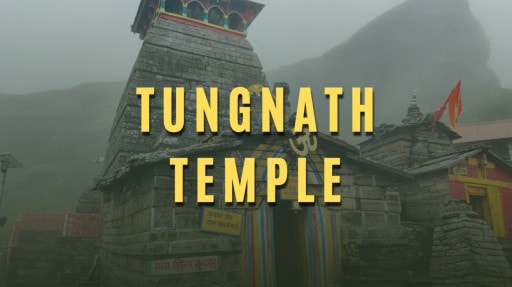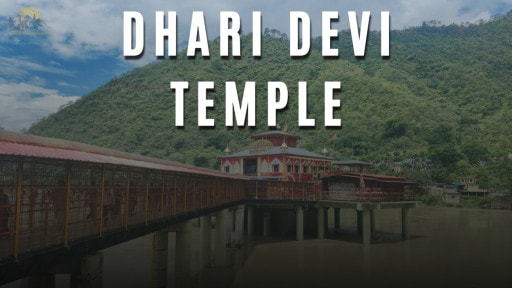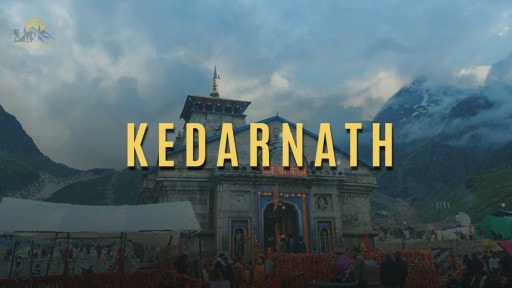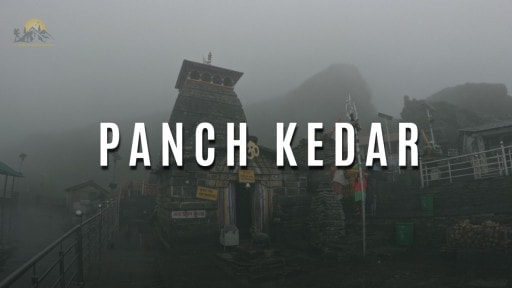Tungnath Temple proudly extends the designation as the highest Shiva temple in the world situated amidst the peak ranges of Tungnath in the Rudraprayag District, Uttarakhand. This religious Hindu temple is perched at an elevation of 3, 680 meters above sea level and it is one among the highest of the five Panch Kedar temples. It is the third temple to be visited in the pecking order of the Panch Kedar.
Tungnath is an ancient era temple built almost 1000 years ago and it’s a true remarkable testament to Indian culture and devotion. Tungnath implies ‘Lord of the peaks‘ which is surrendered to Lord Shiva and is positioned underneath Chandrashila’s peak. As we go deep into this prehistoric age attraction, we get to know the fascinating history, spirituality and spectacle craftsmanship which make this temple a masterpiece.
History of Tungnath Temple
It is deemed Tungnath temple has a great link with Pandavas, the real heroes of epic Mahabharata. The ancient era temple is a mystical charm as it’s associated with hidden myths and tales. As per mythology, there are numerous interpretations behind the formations of Tungnath temple and it’s believed to have been built by the Pandavas. After the epic Kurukshetra War, the Pandavas were seeking forgiveness from Lord Shiva for the sins and bloodshed they caused during the War.
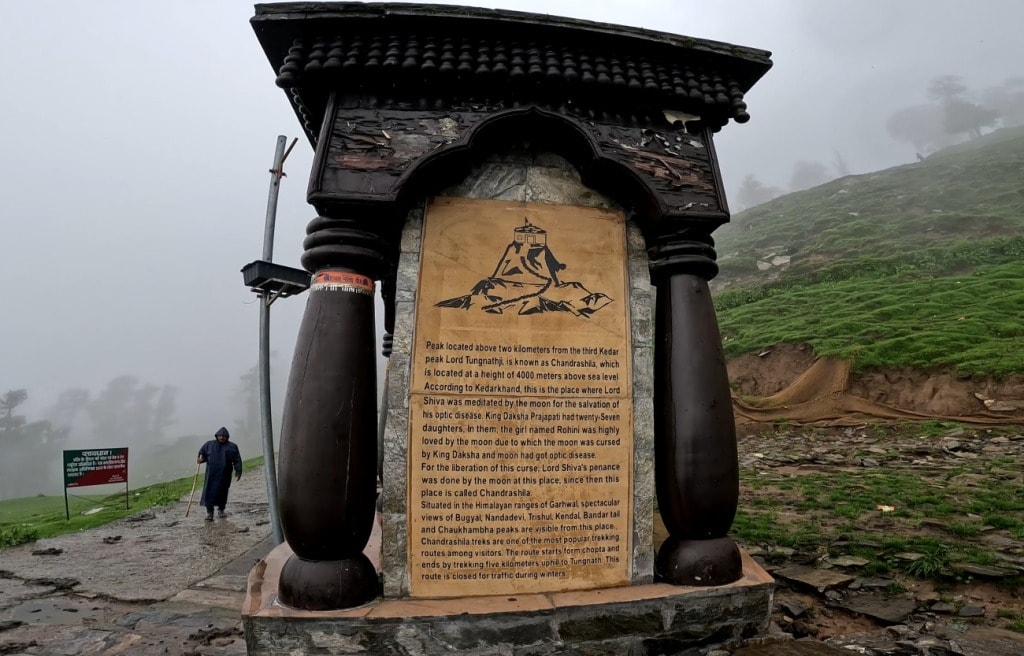
In search of shiva the Pandava brothers climbed the Himalaya mountains where the deity was taking shelter at Guptkashi as he was very angry about all the deaths and wanted to avoid meeting 5 brothers as a result, he changed his avatar into a bull.But ultimately was found by one of five Pandava brothers, Bhima. On being identified, the deity disappeared and reappeared in five different forms at five different locations. So, it is believed Pandavas built temples dedicated to different forms of Lord Shiva at each stopping point.
Thus, the way the greatest holy Panch Kedar temples have been formed and Tungnath Temple “Lord of the Peaks,” is dedicated to the arms of Lord Shiva making it the highest Shiva Temple in the world. There are various myths stating that Lord Rama meditated at Chandrashila peak in the surrounding area of Tunganatha. Another myth that is highly believed is that Ravana the king of Lanka, offered Penance to Lord Shiva during the period when the deity lived here.
Tungnath Temple, Chopta- History, Trek, Opening & Closing Dates [Highest Shiva Temple]
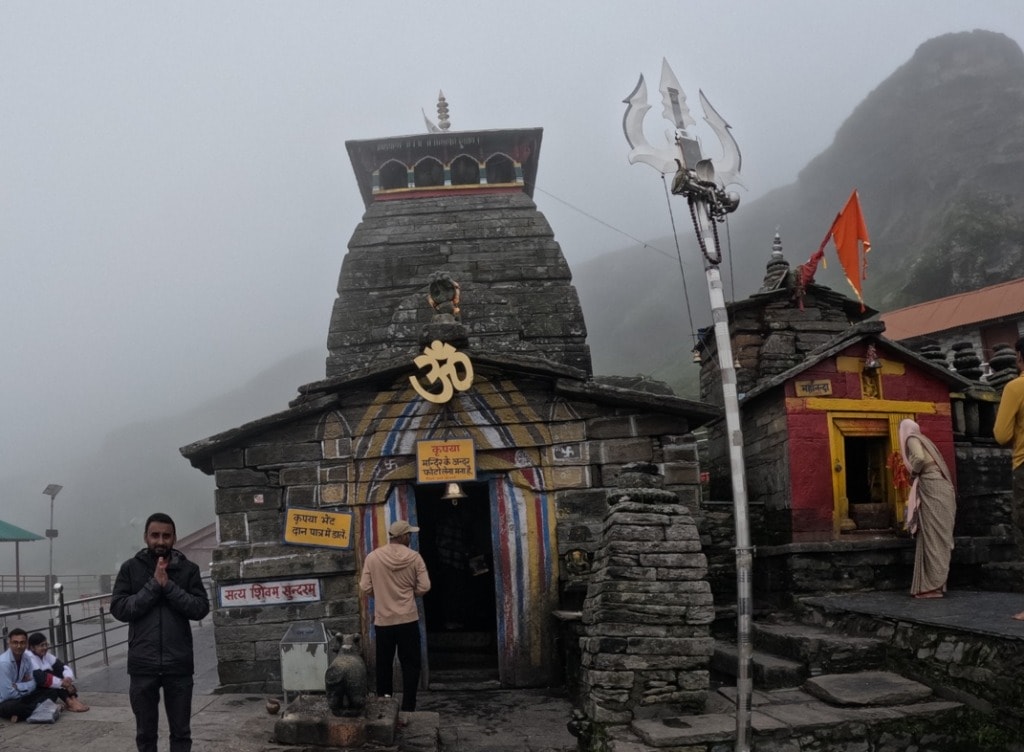
The 1000 years old ancient holy place is a small temple built in North Indian style, which can barely accommodate 10 people in the sanctuary chamber. The shrine is encircled by exceptional designs of various small divinities and the sacred standing black rock, Swayambhu or self-manifest Linga which slant slightly towards the left, at a height of 1 ft, forms the arms of Lord Shiva and it’ worshipped here.
It is believed that this was the place where the hands of the bull emerged and Tungnath Temple is dedicated to Lord Shiva’s arms. There is a statue of Nandi carved out of a rock in front of the sanctuary, which is facing towards Swayambhu in the sanctum. The temple has withstood the test of time, surviving abundant natural disasters and invaders. The temple surroundings are filled with intricate carvings and sculptures depicting various mythological stories.
Tungnath Temple Opening and Closing Dates
The Char Dhams of Uttarakhand are opened in April or May every year on the Vaishakh Panchmi date that is decided by the Badro Kedar Temple Committee on Baisakhi marking the opening dates for Tungnath Temple.
This temple remains closed during winters after Diwali, with temple priests at this time moving their deity to Mukunath located about 19 kilometers away from Tungnath.
- Timings : 6:00 AM – 7:00 PM
- Entry Fee : No entry fee
| Tungnath Temple Opening Date 2024 | 14 May 2024 |
| Tungnath Temple Closing Date 2024 | 07 November 2024 |
Tungnath Temple Timings
| Tungnath Temple | Duration |
|---|---|
| Morning Arti | 06:00 AM |
| Morning Darshan Time | 07:00 AM – 12:00 PM |
| Evening Arti | 06:30 PM |
| Evening Darshan Time | 03:00 PM – 07:00 PM |
How to Reach Tungnath from Chopta
Tunganath temple trip takes you through a spiritual and life changing journey. To reach the top of the temple, people need to do a small trek from Chopta, which is certainly reachable by road from various parts of Uttarakhand. Through the mesmerizing hike you come across stunning peaks such as Nanda Devi, Chowkhamba, Neelkanth, Kedarnath and Panchachuli.

Chpota is also well known as ‘Mini Switzerland of India’ and is considered as the base camp for the trek. The most crucial part of the trek is understanding the route map to reach Chopta. There are various routes available to reach the base point.
What is the motorable route by Road or Bus:
- Road or Motorbike or Taxi Route: Haridwar to Rishikesh (20km), Rishikesh to Devprayag (74 km), Devprayag to Srinagar(34km), Srinagar to Rudraprayag, Rudraprayag to Ukhimath (44km) and Ukhimath to Chopta (46 km).
- Bus Route: Haridwar to Rishikesh (20km), Rishikesh to Sari (193 Km), Sari to Chopta (22km) or take a hike from Sari to Tungnath via Deoria Tal and Rohini Bugyal.
- Bus Route: Haridwar to Rishikesh (20km), Rishikesh to Devparayag (74 Km), Devprayag to Rudraprayag (67 km), Rudraprayag to Chopta (73 km).
By Air:
Dehradun Airport (Jolly Grant Airport) is the nearest airplane terminal which is well connected to major cities. It’s just 20 km from Rishikesh and 35 km from Haridwar, from the airport hire a taxi to Rishikesh and progress towards Chopta by road.
By Rail:
Rishikesh railway station is the nearest train track but has limited train connectivity. Another replacement is Haridwar railroad station which is well associated with major cities in India. From the station take a bus to Ukhimath and proceed to Chopta by hiring a Taxi.
Upcoming Connectivity: By 2025 the journey to Chopta will be made more accessible when the Railway project from the Rishikesh to Karnaprayag will be completed, with Rudraprayag station being the nearest to Chopta and Kedarnath.
Suggested Read: Places to Visit in Rishikesh
Tungnath Trek Details

Chopta to Tungnath:
The trek starts from the base camp, Chopta, and it’s about a 3.5 Km (3 to 4 hours) trek to Tungnath Temple. You hike through dense forests which offer incredible views of the Himalayas and stunning peaks of Nanda Devi, Chowkhamba, Neelkanth, Kedarnath and Panchachuli. Tungnath temple is situated at an altitude of 3680 metres above sea level.
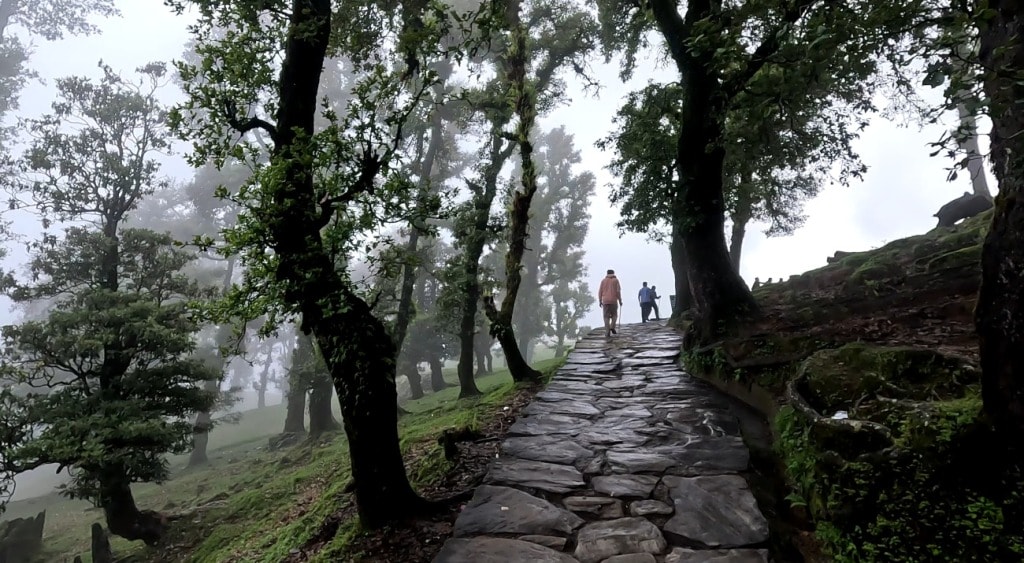
It’s a year-round destination and the trek to Tungnath is available most of the year, except during extreme weather conditions. As the winters are filled with heavy snowfall and trek paths are covered, you may require a guide for safety. But trekking is still possible in winter and it’s an amazing experience to watch the breathtaking Himalayan views covered in white. Another popular route to trek is from Ukhimath, it is marginally longer but is equally satisfying in terms of natural beauty and serenity.
Tungnath to Chandrashila:
Once you reach Tungnath, you will find a walking path towards the left that leads to Chandrashila Summit. It’s a 1.5m trek, at an inclination of about 75 degrees and this stretch is considered a tough one compared to Tungnath. It’s a steep ascent, but once you reach the hilltop of Chandrashila a new territory of the Himalaya appears on the north-eastern vista and is worth taking a risk.
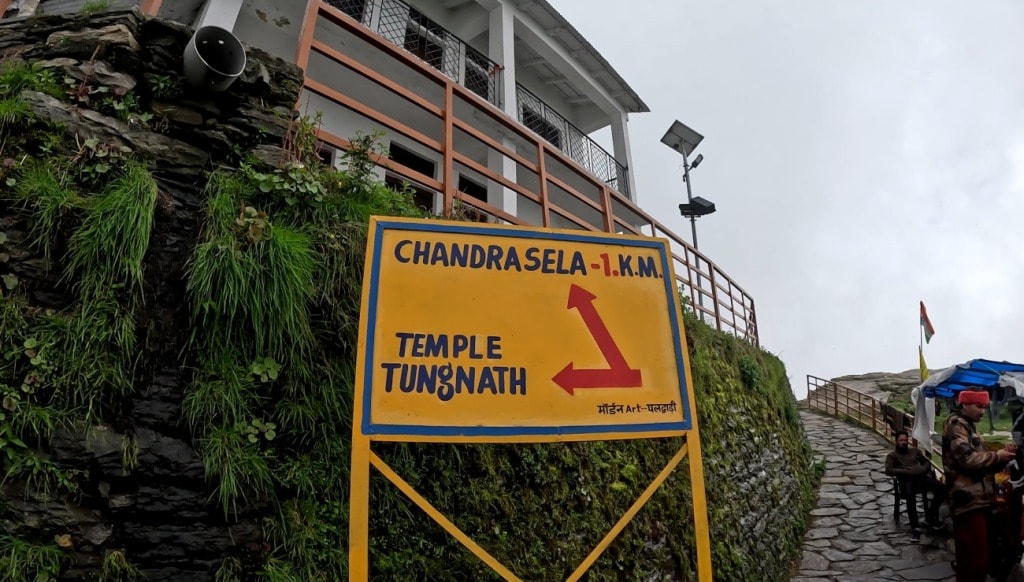
From Chandrashila, you can enjoy the best panoramic views of Nanda Devi, the highest mountain in India and the majestic views of Chaukhamba, Trishul, Thalay Sagar, Mt Kamet, Mt Dunagiri, Kedar Dome, Kedarnath, Mt Nanda Ghunti, Gangotri and Yamunotri peaks
Return Journey:
Most of the explorers end the trek at Chandrashila and return to the base point, Chopta. But few trekkers continue their travel towards Deoria Tal or other nearby attractions.
Chandrashila Summit or Moon Rock:
The Chandrashila summit trek is one of the best experiences most of the trekkers cannot forget. This place is considered a vintage point, located at an elevation of 12,110 feet above sea level and offers a stunning 360-degree view of the splendid Himalayan peaks like mount Kedar, Gangotri, Sathappan, Chakuamba, Nandadevi, Trisul, Bandarpunch etc. There are only some spots in India where you get to see multiple summits from a close distance at an equivalent stretch.
Chandrashila also means “Moon Rock”, it’s just a 1.5m hike from Tungnath and 5km hike from Chopta. As we know there are various myths around this holy place, it is believed that Lord Rama meditated at Chandrashila peak in the surrounding area of Tunganatha after defeating the Lanka king Ravana. Another myth that is highly believed is that the moon-God Chandra spent time here in penance.
On Mule:
If you are not up for the trek, you can hire a mule which takes you to Tungnath temple. It’s a 1-hour ride and they charge you around INR 1300 for one way.
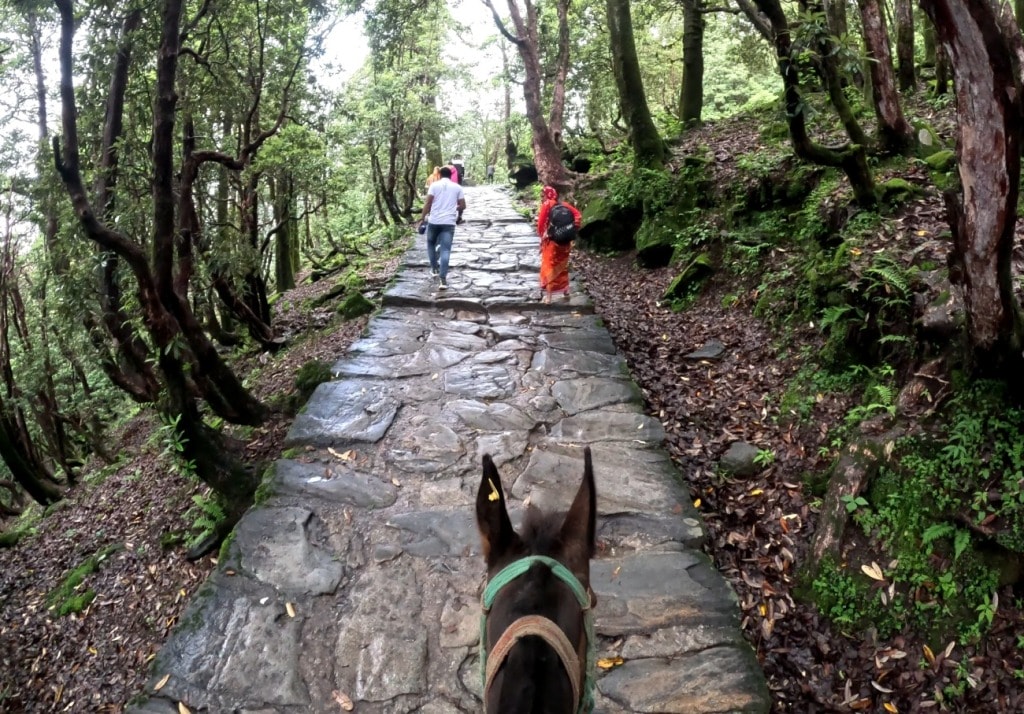
Conclusion
Tungnath trip makes your journey a memorable one and you will fall in love with nature and spiritual exploration. This place is filled with a mix of adventurous treks, calm landscapes, plenty of holy sites, where you get to see the actual beauty of Himalayas and the rich cultural legacy of Uttarakhand.

